- Region
- Águilas
- Alhama de Murcia
- Jumilla
- Lorca
- Los Alcázares
- Mazarrón
- San Javier
-
ALL AREAS & TOWNS
- AREAS
- SOUTH WEST
- MAR MENOR
- MURCIA CITY & CENTRAL
- NORTH & NORTH WEST
- TOWNS
- Abanilla
- Abarán
- Aguilas
- Alamillo
- Alcantarilla
- Aledo
- Alhama de Murcia
- Archena
- Balsicas
- Blanca
- Bolnuevo
- Bullas
- Cañadas del Romero
- Cabo de Palos
- Calasparra
- Camping Bolnuevo
- Campo De Ricote
- Camposol
- Canada De La Lena
- Caravaca de la Cruz
- Cartagena
- Cehegin
- Ceuti
- Cieza
- Condado de Alhama
- Corvera
- Costa Cálida
- Cuevas De Almanzora
- Cuevas de Reyllo
- El Carmoli
- El Mojon
- El Molino (Puerto Lumbreras)
- El Pareton / Cantareros
- El Raso
- El Valle Golf Resort
- Fortuna
- Fuente Alamo
- Hacienda del Alamo Golf Resort
- Hacienda Riquelme Golf Resort
- Isla Plana
- Islas Menores & Mar de Cristal
- Jumilla
- La Azohia
- La Charca
- La Manga Club
- La Manga del Mar Menor
- La Pinilla
- La Puebla
- La Torre
- La Torre Golf Resort
- La Unión
- Las Palas
- Las Ramblas
- Las Ramblas Golf
- Las Torres de Cotillas
- Leiva
- Librilla
- Lo Pagan
- Lo Santiago
- Lorca
- Lorquí
- Los Alcázares
- Los Balcones
- Los Belones
- Los Canovas
- Los Nietos
- Los Perez (Tallante)
- Los Urrutias
- Los Ventorrillos
- Mar De Cristal
- Mar Menor
- Mar Menor Golf Resort
- Mazarrón
- Mazarrón Country Club
- Molina de Segura
- Moratalla
- Mula
- Murcia City
- Murcia Property
- Pareton
- Peraleja Golf Resort
- Perin
- Pilar de la Horadada
- Pinar de Campoverde
- Pinoso
- Playa Honda
- Playa Honda / Playa Paraíso
- Pliego
- Portmán
- Pozo Estrecho
- Puerto de Mazarrón
- Puerto Lumbreras
- Puntas De Calnegre
- Region of Murcia
- Ricote
- Roda Golf Resort
- Roldan
- Roldan and Lo Ferro
- San Javier
- San Pedro del Pinatar
- Santiago de la Ribera
- Sierra Espuña
- Sucina
- Tallante
- Terrazas de la Torre Golf Resort
- Torre Pacheco
- Totana
- What's On Weekly Bulletin
- Yecla


- EDITIONS:
 Spanish News Today
Spanish News Today
 Alicante Today
Alicante Today
 Andalucia Today
Andalucia Today
History rewritten, 4200 year old bronze age fortress unveiled at La Bastida, Totana
This is the first Bronze Age fortification in Europe with this degree of military technology
The greatest problem with archaeology is that the more we learn, the less we know, and developments in 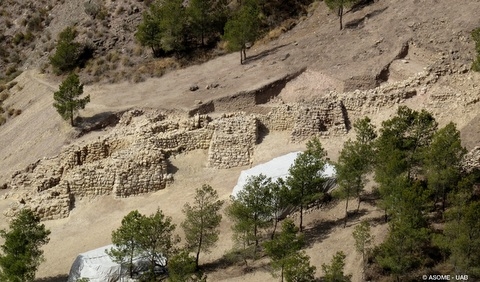 technology and improvements in archaeological techniques create as many questions as they ask.
technology and improvements in archaeological techniques create as many questions as they ask.
A re-excavation of the La Bastida archaeological site first excavated 140 years ago in Totana is re-writing the history books, showing the presence of a sophisticated Bronze Age culture with advanced military technology 400 years earlier than had been previously believed.
This makes the La Bastida site at Totana the most advanced Bronze Age settlement in Europe in political and military terms 4,200 years ago -2,200 BC, and is comparable only to the Minoan civilisation of Crete.
The site is under excavation by the Universitat Autònoma de Barcelona (UAB) under the directorship of Vicente Lull, Professor of Prehistory at the Museum and one of the most experienced archaeologists dedicated to the subject of Bronze Age archaeology in the South-east of Spain.
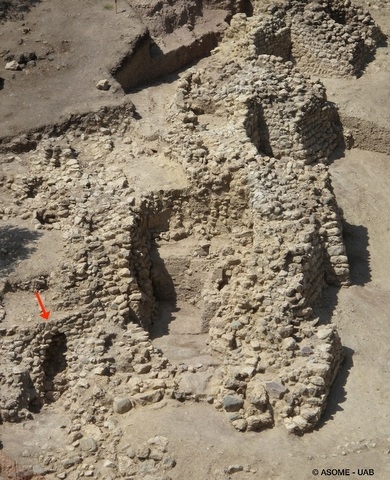 This site at La Bastida was occupied by a population known as the “Argaric culture” which expanded throughout a 500 year period to occupy an area of 33000 square kilometres with sites in the Region of Murcia, Almería, Granada, Alicante and Jaén, Murcia having more sites than any other area.
This site at La Bastida was occupied by a population known as the “Argaric culture” which expanded throughout a 500 year period to occupy an area of 33000 square kilometres with sites in the Region of Murcia, Almería, Granada, Alicante and Jaén, Murcia having more sites than any other area.
Nothing is known about the emergence of this culture, one set of theories expounding the possibility that the Argarics emerged from the local native population, perhaps assisted by the arrival of external technology, whilst another proposes that the technology displayed by this civilisation arrived in the form of settlers with technological skills, but the truth is, there is no evidence to firmly support either theory.
The culture was baptised with the name of the Argarics, as the first settlement to clearly distinguish them as a definable culture was discovered at El Argar, in Almería, and for many years this was believed to have been the location from which the culture emanated, but the confirmation of the dating on La Bastida challenges this theory.
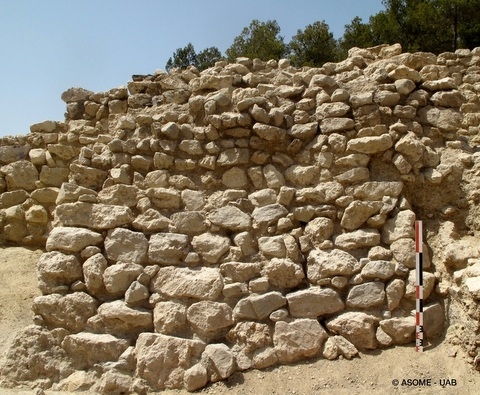 The team from Barcelona University began their work at La Bastida in 2007, clearing the site of the remains of clandestine excavations and surveying the area, before re-excavating the lower section of the site. This last year the works have focused on excavating the entrance gate at the lowest levels, on a steep slope on the side of the hill on which the site is located, with the Barranco Salado and the Rambla of Lébor providing natural defences and water on two sides.
The team from Barcelona University began their work at La Bastida in 2007, clearing the site of the remains of clandestine excavations and surveying the area, before re-excavating the lower section of the site. This last year the works have focused on excavating the entrance gate at the lowest levels, on a steep slope on the side of the hill on which the site is located, with the Barranco Salado and the Rambla of Lébor providing natural defences and water on two sides.
And the results of the recent campaign published this last few days will re-write the history books.
The entrance to the town was fortified, the fortification consisting of a wall measuring two to three metres thick, built with large stones and mortar which would have been 6-7 metres high when it was first constructed. The walls were clad with mortar, making them impossible to scale and impermeable.
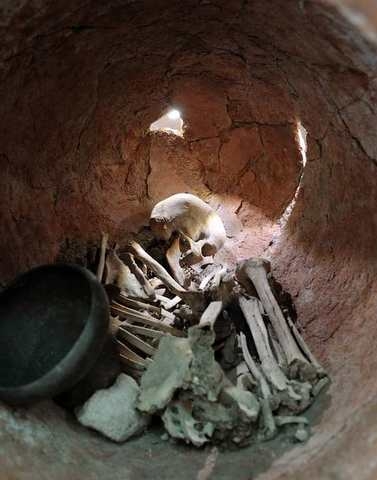 This structure was supported by thick pyramid-based towers four metres apart, with a 40 degree incline. To date, six towers have been discovered along a length of 70 metres, although the full perimeter of the fortification would have measured up to 300 metres. A monumental entrance would have lead to the inner area via a passageway, constructed with strong walls and large doors at the end, held shut with thick wooden beams.
This structure was supported by thick pyramid-based towers four metres apart, with a 40 degree incline. To date, six towers have been discovered along a length of 70 metres, although the full perimeter of the fortification would have measured up to 300 metres. A monumental entrance would have lead to the inner area via a passageway, constructed with strong walls and large doors at the end, held shut with thick wooden beams.
This effectively created a small inner courtyard , which, if the external doors were closed from outside, could become a death trap for those who had entered, exposed to attack from the towers above.
In order for those defending the castle to close the external doors, a secondary door or ogival arched postern gate to give it the correct title, is located next to the main gate, a door through which armed soldiers could exit, closing attackers inside the courtyard.This is to the right of the entrance, giving the soldiers rushing out a natural advantage: Fortresses of this nature were usually approached by a pathway hugging the foot of the fortification, putting the sword arm of attackers against the wall.
The arch is in very good condition and is the first one to be found in Prehistoric Europe. Precedents can be found in the second city of Troy (Turkey) and in the urban world of the Middle East (Palestine, Israel and Jordan), influenced by the civilisations of Mesopotamia and Egypt. This indicates that people from the Ancient Near-East, or having been in contact with technological military knowledge far in advance of anything known in the area at this time, participated in the construction of the fortification.
This ties in with a time of conflict in the Near Eastern Bronze Age, in an area considered to be the cradle of civilization in the West, and from which many of the advances which influenced developments within Europe, flowed. Empires of Bronze Age Mesopotamia included Sumer and the Akkadian, Babylonian and Assyrian empires, all native to the territory of modern-day Iraq, and all with technology which exceeded that of our area of Europe.
Indeed, this style of military fortification didn´t even reach civilisations like the Hittites and Mycenaeans, or city-states such as Ugarit until 400 to 800 years after La Bastida was built.
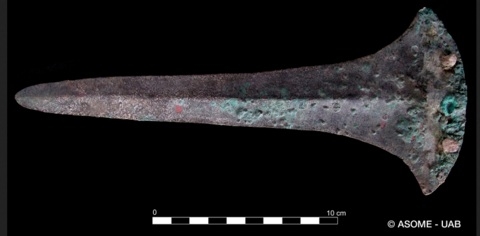 In the Near East, substantial fortifications in this era were as much about a show of power and status as defence, and in truth, the technology of Bronze Age Spain, and general widespread lack of weaponry would have rendered a structure such as this virtually impregnable, and indicates that whoever built it was accustomed to a more advanced form of warfare.
In the Near East, substantial fortifications in this era were as much about a show of power and status as defence, and in truth, the technology of Bronze Age Spain, and general widespread lack of weaponry would have rendered a structure such as this virtually impregnable, and indicates that whoever built it was accustomed to a more advanced form of warfare.
And it would have taken considerable manpower to build this construction, which leads to the possibility that the walls were built using forced labour.
Argaric burials demonstrate a clear class structure, those who controlled the use and manufacture of metal controlling this Bronze Age society. 10% of burials demonstrate an elite society, with rich grave goods, 50% of burials relate to a warrior or artesan level who owned possessions and 40% are clearly slaves or labourers, a distinct structure which is not mirrored in indigenous populations.
There are clear elements of control in this society, a uniformity of measure in ceramics, in the artefacts found, evidence that food and raw materials were distributed and work undertaken by a lower class which indicates s controlled structure, control which must be enforced from somewhere, and by someone, a control which would require a military dominance to maintain.
So who built this settlement and where did they obtain this military know how, were these local tribes, or were these settlers bringing their own culture and technology to the Spanish mainland?
Who were these people?
History will undoubtedly be re-written many times before all of these questions have anything resembling an answer.
A Unique Archaeological Park in Spain
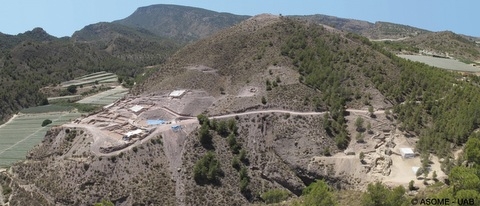
La Bastida is a unique working archaeological park, in which visitors can learn not only about the history of the site and the Argaric culture, but also about the process of modern archaeology and how archaeologists extract information from the finds they make. Providing an ongoing commitment can be obtained to continue work on this important excavation, a museum will be opened on the site, together with research and documentation centre, as work continues to conserve this key to the past. Click for more information about La Bastida, Totana.
The excavations at La Bastida are directed by the Research Group in Mediterranean Social Archaeoecology (ASOME) of Universitat Autònoma de Barcelona (UAB), formed by lecturers Vicente Lull, Rafael Micó, Cristina Rihuete and Roberto Risch. The research group receives the support and funding of the Department of Culture, Regional Cultural Ministry of Murcia, the UAB, and the Totana City Council. The Spanish Ministries of Industry, Trade and Tourism, and of Economics and Competitiveness also give financial support to the project.
Images courtesy of ASOME
Click Totana tourist office to contact by email or for phone number.
There are three main articles about La Bastida and the Argarics written:
Background to the Argaric culture, their customs and practices, technology, burials and general information. Click Argarics.
General information about La Bastida and this specific site, as well as some background information about the Argarics, Click La Bastida Totana
Information about the specific finds of this year, and the importance of the fortifications discovered.
Click Argaric fortifications at La Bastida.
Cartagena
El Carmoli
Islas Menores and Mar de Cristal
La Manga Club
La Manga del Mar Menor
La Puebla
La Torre Golf Resort
La Union
Los Alcazares
Los Belones
Los Nietos
Los Urrutias
Mar Menor Golf Resort
Pilar de la Horadada
Playa Honda / Playa Paraiso
Portman
Roldan and Lo Ferro
San Javier
San Pedro del Pinatar
Santa Rosalia Lake and Life resort
Terrazas de la Torre Golf Resort
Torre Pacheco
Aledo
Alhama de Murcia
Bolnuevo
Camposol
Condado de Alhama
Fuente Alamo
Hacienda del Alamo Golf Resort
Lorca
Mazarron
Puerto de Mazarron
Puerto Lumbreras
Sierra Espuna
Totana
Abaran
Alcantarilla
Archena
Blanca
Corvera
El Valle Golf Resort
Hacienda Riquelme Golf Resort
Lorqui
Molina de Segura
Mosa Trajectum
Murcia City
Peraleja Golf Resort
Ricote
Sucina
Condado de Alhama
El Valle Golf Resort
Hacienda del Alamo Golf Resort
Hacienda Riquelme Golf Resort
Islas Menores and Mar de Cristal
La Manga Club
La Torre Golf Resort
Mar Menor Golf Resort
Mazarron Country Club
Mosa Trajectum
Peraleja Golf Resort
Santa Rosalia Lake and Life resort
Terrazas de la Torre Golf Resort
La Zenia
Lomas de Cabo Roig
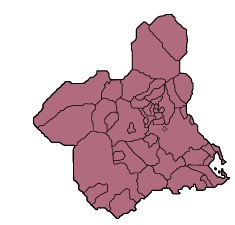
CAMPOSOL TODAY Whats OnCartagena SpainCoronavirusCorvera Airport MurciaMurcia Gota Fria 2019Murcia property news generic threadWeekly Bulletin



